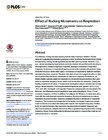Effect of Rocking Movements on Respiration
dc.contributor.author
Omlin, Ximena
dc.contributor.author
Crivelli, Francesco
dc.contributor.author
Heinicke, Lorenz
dc.contributor.author
Zaunseder, Sebastian
dc.contributor.author
Achermann, Peter
dc.contributor.author
Riener, Robert
dc.date.accessioned
2019-06-11T11:26:53Z
dc.date.available
2017-06-14T07:24:33Z
dc.date.available
2017-07-05T07:47:10Z
dc.date.available
2017-06-12T03:20:09Z
dc.date.available
2017-06-19T16:13:25Z
dc.date.available
2017-11-21T13:08:20Z
dc.date.available
2019-06-11T11:26:53Z
dc.date.issued
2016-03
dc.identifier.issn
1932-6203
dc.identifier.other
10.1371/journal.pone.0150581
en_US
dc.identifier.uri
http://hdl.handle.net/20.500.11850/211290
dc.identifier.doi
10.3929/ethz-a-010796987
dc.description.abstract
For centuries, rocking has been used to promote sleep in babies or toddlers. Recent research suggested that relaxation could play a role in facilitating the transition from waking to sleep during rocking. Breathing techniques are often used to promote relaxation. However, studies investigating head motions and body rotations showed that vestibular stimulation might elicit a vestibulo-respiratory response, leading to an increase in respiration frequency. An increase in respiration frequency would not be considered to promote relaxation in the first place. On the other hand, a coordination of respiration to rhythmic vestibular stimulation has been observed. Therefore, this study aimed to investigate the effect of different movement frequencies and amplitudes on respiration frequency. Furthermore, we tested whether subjects adapt their respiration to movement frequencies below their spontaneous respiration frequency at rest, which could be beneficial for relaxation. Twenty-one healthy subjects (24–42 years, 12 males) were investigated using an actuated bed, moving along a lateral translation. Following movement frequencies were applied: +30%, +15%, -15%, and -30% of subjects’ rest respiration frequency during baseline (no movement). Furthermore, two different movement amplitudes were tested (Amplitudes: 15 cm, 7.5 cm; movement frequency: 0.3 Hz). In addition, five subjects (25–28 years, 2 males) were stimulated with their individual rest respiration frequency. Rocking movements along a lateral translation caused a vestibulo-respiratory adaptation leading to an increase in respiration frequency. The increase was independent of the applied movement frequencies or amplitudes but did not occur when stimulating with subjects’ rest respiration frequency. Furthermore, no synchronization of the respiration frequency to the movement frequency was observed. In particular, subjects did not lower their respiration frequency below their resting frequency. Hence, it was not feasible to influence respiration in a manner that might be considered beneficial for relaxation.
en_US
dc.format
application/pdf
dc.language.iso
en
en_US
dc.publisher
PLOS
dc.rights.uri
http://creativecommons.org/licenses/by/4.0/
dc.title
Effect of Rocking Movements on Respiration
en_US
dc.type
Journal Article
dc.rights.license
Creative Commons Attribution 4.0 International
dc.date.published
2016-03-08
ethz.journal.title
PLoS ONE
ethz.journal.volume
11
en_US
ethz.journal.issue
3
en_US
ethz.journal.abbreviated
PLoS ONE
ethz.pages.start
e0150581
en_US
ethz.size
11 p.
en_US
ethz.version.deposit
publishedVersion
en_US
ethz.code.ddc
DDC - DDC::6 - Technology, medicine and applied sciences::610 - Medical sciences, medicine
en_US
ethz.identifier.wos
ethz.identifier.scopus
ethz.publication.place
San Francisco, CA
ethz.publication.status
published
en_US
ethz.leitzahl
ETH Zürich::00002 - ETH Zürich::00012 - Lehre und Forschung::00007 - Departemente::02140 - Dep. Inf.technologie und Elektrotechnik / Dep. of Inform.Technol. Electrical Eng.::02650 - Institut für Automatik / Automatic Control Laboratory
en_US
ethz.leitzahl
ETH Zürich::00002 - ETH Zürich::00012 - Lehre und Forschung::00007 - Departemente::02070 - Dep. Gesundheitswiss. und Technologie / Dep. of Health Sciences and Technology::03654 - Riener, Robert / Riener, Robert
en_US
ethz.leitzahl.certified
ETH Zürich::00002 - ETH Zürich::00012 - Lehre und Forschung::00007 - Departemente::02070 - Dep. Gesundheitswiss. und Technologie / Dep. of Health Sciences and Technology::03654 - Riener, Robert / Riener, Robert
ethz.date.deposited
2017-06-12T03:21:20Z
ethz.source
ECIT
ethz.source
ECOL
ethz.identifier.importid
imp59366ba486ec298634
ethz.identifier.importid
imp5936544251d2988629
ethz.identifier.importid
imp593654e85bd7056450
ethz.ecolpid
eth:50159
ethz.ecitpid
pub:176412
ethz.ecitpid
pub:185577
ethz.eth
yes
en_US
ethz.availability
Open access
en_US
ethz.rosetta.installDate
2017-11-21T13:04:15Z
ethz.rosetta.lastUpdated
2024-02-02T08:16:27Z
ethz.rosetta.versionExported
true
dc.identifier.olduri
http://hdl.handle.net/20.500.11850/164586
dc.identifier.olduri
http://hdl.handle.net/20.500.11850/156068
dc.identifier.olduri
http://hdl.handle.net/20.500.11850/114614
ethz.COinS
ctx_ver=Z39.88-2004&rft_val_fmt=info:ofi/fmt:kev:mtx:journal&rft.atitle=Effect%20of%20Rocking%20Movements%20on%20Respiration&rft.jtitle=PLoS%20ONE&rft.date=2016-03&rft.volume=11&rft.issue=3&rft.spage=e0150581&rft.issn=1932-6203&rft.au=Omlin,%20Ximena&Crivelli,%20Francesco&Heinicke,%20Lorenz&Zaunseder,%20Sebastian&Achermann,%20Peter&rft.genre=article&rft_id=info:doi/10.1371/journal.pone.0150581&
Files in this item
Publication type
-
Journal Article [128830]

